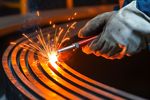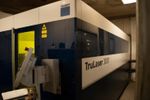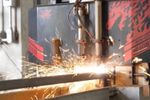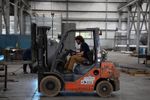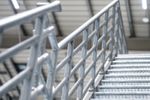If you need to get a structural welding certification in North America, you can take plate welding certification tests administered by two entities: the American Welding Society (AWS) and the Canadian Welding Bureau (CWB).
Both of these organizations have well-respected procedures and processes that you can use to test your welding staff and get them certified so that you can perform quality welds and meet customer requirements for custom metal fabrication jobs such as steel tanks, heavy ducts, industrial carts, and industrial access equipment.
Both the AWS and CWB plate welding certification tests follow a common sequence:
- Contact an inspector to administer the test(s)\
- Have the welder being tested perform the welds you want to test\
- Cut the welded metal into the appropriate-sized coupons for quality testing\
- Test the welded materials using the procedure’s approved testing methods
In the case of CWB testing, the welding supervisor who administers the test can be a staff member who has gone through the requisite training. They become certified to grant temporary certifications to other welders; those certifications will eventually need to be verified by an accredited testing service — such as World Testing. AWS tests, though, can only be administered by outside testing services or schools.
Types and Positions of Welds for Certification Testing
Once you have your inspector lined up, you need to determine which plate welding certification tests you’d like to administer. There are eight different types, segmented according to type and position.
These eight different welds are divided into two different joint types for welding test plates: fillet welds and groove welds.
Fillet welds join two metal plates that are perpendicular to one another. Groove welds join parallel pieces of metal — the space separating them is filled in by the weld.
Plate welding certification tests can be performed in four different positions:
 A horizontal groove weld test plate
A horizontal groove weld test plate
- Flat\
- Horizontal\
- Vertical\
- Overhead
A flat welding position positions the plates so that the welder lays his or her bead down parallel to the ground.
In a horizontal position, the welder has to join an upper and lower plate by moving on a horizontal axis (left to right or right to left).
A vertical weld position is basically a horizontal weld position rotated 90 degrees, making it so that the welder has to build their weld vertically (from top to bottom or from bottom to top).
The overhead position is considered the most difficult but is really just a flat welding position turned upside down. It’s challenging because the welder must come in under the plate and weld from below.
The system for classifying the eight weld types has eight corresponding codes that describe all the possible permutations:
 Plate Welding Test Positions
Plate Welding Test Positions
- 1F — Flat Fillet
- 2F — Horizontal Fillet
- 3F — Vertical Fillet
- 4F — Overhead Fillet
- 1G — Flat Groove
- 2G — Horizontal Groove
- 3G — Vertical Groove
- 4G — Overhead Groove
Many plate welding certification tests are performed using groove welds because they stipulate that a groove weld certification also qualifies a welder to do fillet welds in the same position.
Also**, if a welder passes an AWS welding certification test, they will automatically gain the certifications for the “lesser” tests** in the same general category (fillet or groove). So, for example, if a welder passes the 4G welding certification test, they will also become certified for the 3G, 2G, and 1G positions.
CWB does not “grandfather” tests in the way AWS does. To become CWB certified for a position, a welder must pass that specific test.
Ways to Test the Quality of a Weld
 A welding certification test plate ready to be cut into coupons for testing
A welding certification test plate ready to be cut into coupons for testing
Once you have a welded plate, it is cut up into coupons that will be used to test the strengths of the weld. If it holds, the welder will gain the certification in question. If the weld doesn’t pass the test, the welder will have to try again.
There are two ways to test the strength of a weld: destructive testing and non-destructive testing.
Destructive testing typically involves putting a test plate coupon in a press brake to see if it comes apart. If it doesn’t, the weld passes.
Non-destructive testing can be as simple as a visual inspection or can include more advanced non-invasive methods such as liquid dye penetration testing, radiographic testing, or X-rays.
CWB plate welding certification tests rely on destructive testing — namely the good old press brake.
AWS plate welding certification tests emphasize non-destructive testing — visual inspections and X-ray testing.
Other Differences Between AWS and CWB Welding Certification Tests
AWS and CWB welding certification tests differ in three main ways besides their testing methods.
The first difference has to do with CWB’s restrictions on grinder usage. To meet CWB standards, you can’t use a grinder during prep or to grind a weld down. You can only use it for cleaning. Per CWB standards, all prep work and cleanup has to be done with a pearl pad or brush.
Second, CWB requires that you stop and restart in the middle of welds you submit for testing. This means welders who want to get CWB certified have to have to master terminating welds and know how to tie in when they pick the weld back up. Otherwise, the finished weld will not maintain its integrity during testing.
Lastly, AWS is a lot more restrictive when it comes to soapstone. Basically, no soapstone can get folded into a weld if it is going to meet AWS welding certification standards. If the X-ray test picks up on any inclusion (and it will), the weld fails.
Beyond Welding Certification Tests
When you’re a custom metal fabricator, you don’t necessarily get to choose which welding standards you abide by — it’s really up to the client.
That’s why we at Southern Metal Fabricators have invested in certifying our welders in several different procedures — including ones that meet AWS, CWB, and API-650 standards — so that we’re ready to go when our customers require certain specifications.
Beyond the paperwork, we see additional value in getting these certifications. Mastering the various procedures has helped us develop a deep collective welding knowledge base. Which makes us better welders capable of producing better custom-fabricated products — no matter which standards are employed on a particular job.
If you have a custom metal fabrication project that requires quality welds or that needs to meet a challenging welding standard, please give us a call at 1.888.421.9661. Chances are we’ll be able to say, “Yes, we can do that!”

